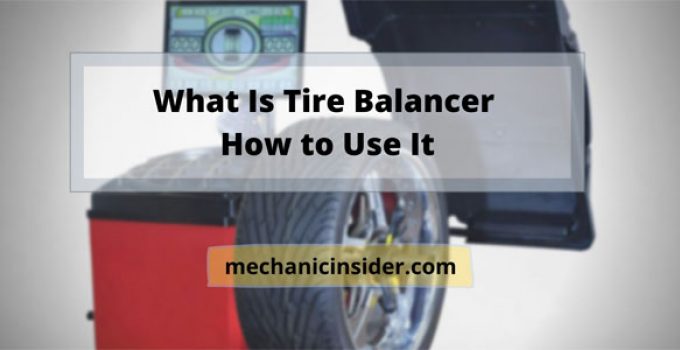Balance is an essential component in the wheel assembly. It is important to ensure that there are no weight imbalances and this is necessary to make sure the tire moves correctly at high speeds. The tire needs to be balanced, and any imbalances corrected.
This is essentially done via a tool known as a tire balancer. Tire balancing can be a tedious and difficult job, but a tire balancer can make it easy, provided you know how to go about using it.
So, today, we’ll learn what a tire balancer is and how to use it. Let’s get started.
Tire Balancing
The distribution of mass in a tire is important, and if it is uneven, it can shift or rotate in unwanted ways. When driving a car with an imbalanced wheel, this can damage the axle of your car and lead to a very uncomfortable riding experience.
Tire balancing is all about finding the imbalances and then adjusting them by adding weights to counterbalance them. That being said, the main thing one should know about tire balancing is where and how the imbalances result and how they are identified.
There are primarily two types of balances that you should be aware of when a tire is assembled. They are:
Static Balance
This refers primarily to the center of mass of the tire. In case you didn’t know, the center of mass of an object is a point where the mass of the object is concentrated onto. Why is this important, you ask? Let’s look at an example.
Understanding Static Balance
Suppose you have a uniform metal rod. Ideally, if the rod is made uniformly of the same material and is similar at every point, the center of mass of the rod should be in the middle. If you place the exact middle of the rod on your finger, you should see it being balanced and won’t tip over to any side.
This is all assuming that the rod is perfectly uniform and in shape and size. If the rod was a bit heavier on the left side, you’d notice that when you try to balance it in the middle, the rod will try to move counter-clockwise and fall.
Balancing the Wheel
As you can see, the rod is not balanced. The center of mass of the rod has shifted. If you slowly shift your finger from the middle of the rod to the left (heavier) side, you’ll see that the counter-clockwise movement will decrease until it becomes balanced again. This is the new center of mass.
During assembly of a tire, there can be times when the weight of the tire is not even, and thus, the center of mass is not located at the center of the wheel. While you could shift your finger to balance the uneven rod in the example above, this is not possible for a tire.
The center of mass needs to be located in the center of the wheel, where it will be connected to the axle. Correction weights need to be applied on the wheel to counteract the imbalance. Aligning the center of mass of the wheel like this is known as achieving static balance.
Dynamic Balance
While static balance has been discussed, you should also take note of another type of imbalance that is common in tires. The other type of imbalance is known as dynamic imbalance and is usually noticed when the tire is rotating.
Understanding Dynamic Balance
When a wheel is mounted on an axle and made to rotate, if the wheel is imbalanced, you will notice an odd motion. If you view the wheel from the front as per its axis or rotation, you’ll notice that it slightly deviates.
There is a side-to-side motion as the wheel spins. Depending on the axle, this motion will be more pronounced.
Identifying Dynamic Imbalance
A dynamic imbalance is often only noticeable when the wheel is in motion with the axle. When driving with a dynamically imbalanced wheel, the driver will often feel vibrations when driving. These vibrations are even more noticeable at higher speeds.
Not only that, but the side-to-side motion quickly wears down a tire alongside making driving a car uncomfortable. If left unchecked, it could very well damage suspension systems.
As such, for dynamic imbalances to be identified, the wheels need to be moving or in motion. The deviation needs to be checked and corrected with counterweights.
When Is a Tire Balancer Used?
As you are aware of how imbalances can result in your tires and how it affects your car, you probably understand why a tire balancer is needed. There are two specific times you’ll need to make use of a tire balancer. They are:
- After Repair or Replacement
After repair or replacing a tire, it is important to use a tire balancer to check whether the repairs have caused an imbalance in the tire. This is an important safety check as sometimes replacing your tires can result in tires that haven’t been weighed properly. It’s better to check the balance beforehand.
- When New Tires Are Purchased
Whenever you buy new tires, always have the balance checked. You don’t want to go out of the store with improperly weighed tires that cause uncomfortable rides. Always have your tires checked for balance when you buy them.
Aside from these, you’ll often make use of a tire balancer for inspection. Long use and rides can wear your tire down and can cause slight shifts in weight.
How Does a Tire Balancer Work?
Similar to the two types of tire balance, there are two types of tire balancers. They work in different ways and use specific mechanisms to detect imbalances. And they are:
Static Balancer
These were the first type of tire balancers to be used. The tire remains stationary during the testing portion, and the machine detects the deviation of the tire if it is unbalanced. These machines often contain a glycerine-filled chamber with an air bubble.
This bubble moves in the opposite direction of the deviation caused by the imbalance. And this movement can be used to gauge how much counterweight is needed to fix the tire. This led to them being called bubble balancers.
While they are easy to use, they aren’t precise and cannot sense dynamic imbalance. As a result, they aren’t as common as they used to be.
Dynamic High-Speed Spin Balancer
The static balancer had some limitations that prevented it from giving out precise results. This dynamic, high-speed spin balancer is another type of tire balancer that expands on it and provides more precision. And this is why it is the most common tire balancer.
This tire balancer is automated and requires you to set the tire on the machine and input its size on to the machine. The tire is then made to spin at 60 miles per hour with the machine locating deviations and deflections.
Moreover, these are then shown on an LED screen allowing the user to locate them on the tire and add necessary counterweights.
These machines also display an accurate amount of weight required to counterbalance the tire. And these make them more reliable and accurate than static or bubble balancers.
How to Use a Tire Balancer
For this tutorial, we’ll assume the particular balancer used is a dynamic tire balancer. They’re more common and available than static balancers. The steps to using a tire balancer are:
Clean Your Tire
Before you want to go about balancing your tire, clean it up. Built-up debris and grime can cause some odd readings. Make sure to clean the inside of your wheel alongside the treads.
Reset the Tire Balancer
If your machine was on before, it is best to reset it by turning it on or off. If you don’t reset it, you might suffer from zero error, which shows a reading that’s higher than intended since the measurement wasn’t reset to zero beforehand.
Mount the Tire
Once your tire has been cleaned, and the balancer reset, you can proceed to mount your tire on the machine. If needed, it is best to seek assistance as some tires can be quite heavy.
Some balancers feature a cone that you need to align the center of the tire with. Others feature a pin-plate method where you need to secure the tire on to it. Identify the system and then mount the tire.
Input Wheel Dimensions
For the tire balancing to work properly, you need to input the proper data onto the wheel balance machine. There are three data fields you must fill up, which are the offset, wheel width, and wheel diameter. For measuring the offset, you need to use the offset arm of the tire balancer.
It is a movable arm-like extension present on most tire balancer machines. You simply need to hold the offset arm and place it against the outward edge of the wheel’s rim. Wait for a bit, and you’ll hear a sound, and a reading will be recorded.
You opt to measure the diameter and width manually using tools, or you can use the specifications given when you bought the wheel. Once you have the measurements, simply input them.
Lower the Hood
Once the measurements have been entered, lower the hood of the machine and let the tire spin. While the tire is spinning, the machine will detect the imbalances and display them on the screen. Only remove the hood after the tire has stopped spinning.
Add the Necessary Weights
After the tire has finished spinning, check the screen for the imbalances and the required counterweights. Search for the necessary weights and attach them to the wheel. If the imbalance is too big, the tire might be a lost cause, and you’ll need to replace it.
Spin the Wheel Again
Lower the hood of your tire balancer again and let the tire spin. Check for any other imbalances and repeat the previous steps to correct them. Then check until you are satisfied with the results.
How to Calibrate a Tire Balancer
Calibrating a tire balancer from time to time is necessary to ensure precision and reliability. Since you’ll be measuring many different tires with varying weights, heavier tires might cause some strain on the parts. This can lead to a lack of sensitivity in the measuring apparatus.
Before attempting to calibrate a tire balancer, it is best to refer to the instruction manual for your particular tire balancer. Check to see if there are any special instructions for calibrating a tire balancer. Generally, a calibration process involves the following steps.
Reset the Machine and Mount a Test Tire
Turn the machine off and then on. For your test tire, make sure the rim is not damaged and use an average-sized tire. A 15-inch tire is recommended.
Enter the Required Parameters
Enter the offset, width, and diameter readings of the test tire. After doing so, hold the D+C button until the indicators stop blinking.
Spin the Wheel
Lower the hood and let the wheel spin. After spinning, you’ll get an alert telling you to add 100 g of weight. Add the weight to the outside of the rim. Then allow it to spin again.
Save the Data
Save the data and then reset the machine again. Calibration is done.
Conclusion
A tire balancer is an amazingly helpful tool and is essential for ensuring a comfortable ride and making sure your tires last longer. As you can see, they are not too difficult to operate as this article might have shown you.


![How To Make 5.7 Hemi Faster – [EASY] How To Make 5.7 Hemi Faster – [EASY]](https://mechanicinsider.com/wp-content/uploads/2020/10/How-to-make-5-7-hemi-faster-211x150.jpg)
